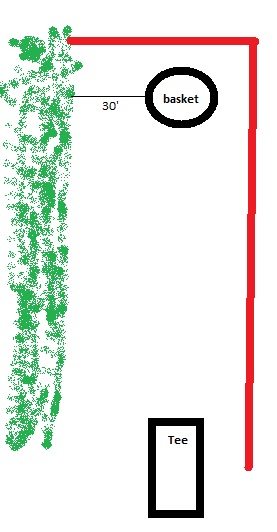Hi John, would love some input here:
I am designing a course with some heavy flow restrictions, and after multiple iterations of trying different options, we have fund one to be optimal. However, there is one solitary hole that doesn't quite work very well, but seems to be pretty mandatory to connect parts of the course and maintain good flow.
It is a small chunk of land with river on one side and walking path on the other. It starts wide but tapers down to almost nothing (it worked much better in reverse because of that). This leaves us with little room to work with to avoid high speed errant shots (for pedestrian protection). After scouring this land and pulling my hair out for a while, I found a pretty unconventional hole. It is about 120' with a tee pad 10' or so from a 2.5' or so tree gap, and the basket on a small knoll.
Pros:
- Offers a highly controlled shot that every player should be able to execute
- Slows disc speed to protect pedestrians
- Uses very little land
- Provides a very unique hole seen close to nowhere in my experience (250+ courses in 41 states)
- Provides decent risk/reward (any player can lay up a putt 15' for an easy 3, but most will risk the 2)
Cons:
- many players will hate this hole
- could be conceived "gimmicky"
- the "risk" isnt very high. you could hit the trees and salvage a 3 sometime. double mandoing the trees or adding a small OB island around the trees could change this.
- many players will throw overhand shots through the gap. this could be remedied by screwing some small down trees/branches across the gap at say 8' high and up or something...
So basically I'd be very interested to hear your opinion on a hole like this.
Also, I'm wondering if you have any formula for "distance to gap":"gap width" ratio. i.e. if your double mando is 20 feet off the pad, and your double mando is 6 feet wide, the ratio would be 3.33. The higher, the harder... What is the maximum to not be considered lucky? Is it even a linear correlation?
Thanks for the help!!
Logan, your timing is interesting, as I'm currently working on a course with very challenging routing, mostly due to a paved walking path and an uncrossable creek that sometimes get very narrow. Sounds like we've been looking at some similar puzzles. I like your thoughtful list of Pros and Cons -- you've obviously spent a lot of time finding the right answers, and you've obviously been very conscientious about safety issues, so I applaud you.
In addition to just being very careful and looking at over a dozen routing variations, I'm able to plant trees on this one, so that's a huge help.
When you count on players using a slower disc, as I almost did several times, you're asking for trouble. Some players, especially new ones, don't even own slower discs. Yes, they SHOULD throw with less speed on such a short hole, but is that going to be enough to keep pedestrians safe?
Also, when you go into it knowing a good number of players are going to "hate" it, to use your word, that would really make me pause.
I guess my bottom line question is this: if the hole is 120' long, do you really need it there? Maybe it makes sense to just add 120' to the walk between the previous hole and the next hole. Of course, that means adding a hole somewhere, or splitting up a hole somewhere. It's hard to say without knowing all the ins and outs, but based on what you've said, it sounds like there may still be a better solution out there.
As for a gap width formula, there's a third factor you need to include. That's the distance from the gap to the pin or landing area. If you have to hit a 12' gap that's 200' away, it matters if the pin is 50' past the gap or 100' past the gap. Different disc, different throwing speed, different success percentage.
Think about what Chuck said, and look at the percentage of players who are going to make the shot.



